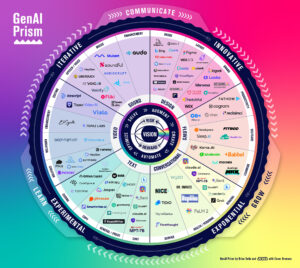
I asked Jason Falls for a guest post to mark the release of his new book, “No Bulls–t Social Media“
Few can argue with the umbrella point of Brian’s latest book. Technology and the reclaiming of the marketplace by consumers has brought about the End of Business As Usual. Companies are collaborating internally, with customers and even one another far more than ever before. Businesses are becoming social, not just using social media. We’re conducting business in a new world.
But let us not forget that while these social and power structure shifts in the marketplace seem to indicate that many businesses and their practices were broken, they weren’t completely broken. We needed a new timing belt, not an entirely new engine.
The process we should know that still holds its own in the new business landscape is strategic planning. For most companies, strategy is top-down. You have business strategies that are then broken down into discipline strategies (like marketing) which can then be fractured out into strategies around practices like public relations or even social media. These ladder up to help accomplish discipline strategies which then aide in the business strategy completion.
For social media marketing specifically the biggest challenge most companies have in approaching the practice strategically is they lack a clear understanding of what social media marketing can do for the business. Identifying the possibilities is the critical first step in the strategic planning process. You’re not going to use social media marketing to solve supply chain issues in your distribution network because social media marketing doesn’t drive that type of activity.
Over the course of the last few years working with clients and seeing other companies implementing social media marketing efforts, I’ve identified seven primary business drivers of social media marketing. These seven things are what social can do for your business. They are:
- Enhance branding and awareness
- Protect reputation
- Extend public relations
- Build community or loyalty
- Extend customer service
- Facilitate research and development
- Drive sales or leads
Focusing on one, three or even all seven of these areas gives you a direction … a purpose for your efforts. Now you can dive into the business process you hopefully already know how to do: plan strategically. Set goals, delineate specific objectives that help accomplish those goals, then excise strategies and tactics that support those objectives.
When you do this, you approach social media marketing strategically. This eliminates two primary pain points for many businesses diving into social marketing. It keeps you from falling victim to the shiny new object syndrome and helps you measure what matters. If your activity can’t be traced upward to support your goal or goals in one or more of the business drivers, then you don’t do it.
Your objectives hopefully have specific triggers that make measuring easy. An example of a strong objective statement might be, “We want to reduce call center costs by 40% by end of year.” How do you measure you success with this objective? Look at your call center costs. How do you achieve the drop? Develop strategies that move customers to social channels or your website to facilitate support rather than calling.
No worrying about Twitter followers or ReTweets, Likes or Lists here. You measure what you’re trying to accomplish.
Strategy is not likely foreign to you. And as much as Brian’s assertions are right — business as usual no longer exists — some of our business practices are still not only relevant, but required.
Don’t be distracted by the technology, the tools, the new environment or even the fascinating possibilities. Approach your social marketing strategically. And the End of Business As Usual won’t mark the end of your business.
Find more about the seven business drivers of social media marketing, including case studies and ways to measure them in Jason’s new book, co-authored with Erik Deckers, No Bulls–t Social Media: The All-Business, No-Hype Guide to Social Media Marketing. It’s available on Amazon or at many retail bookstores.
Image Credit: Shutterstock





Implementing social media to optimise marketing strategy should be do by all businesses. I run a social media consultancy and one of the things that I hear most often is CEO’s saying they just don’t have time to keep up with all the changes.
Here is my input because I agree with your view here.Since you can truly only reach a small % of your customers using social media (and that is a fact today) the strategy and results from that interaction has to fit what is going on. Meaning a large company will never drive sales. Seriously I doubt ever by using Social Media. Scale is not there. Which is why I cringe when the word Marketing comes into play and why I see a lot of hype and almost outright fraud from the well known voices in Social Media. Too many small businesses think their sales will zoom quickly when most people refuse to talk to brands via social (we talk with friends, colleagues, family etc first and foremost).
That said the small % who do talk offer a boat load of data. You can head off Quality Assurance problems, handle some customer service, and have R&D focus groups like never before. And to ignore this gift of technology to help improve your everything from customer connectivity to boost image and awareness and mine insights is suicide if you ask me.
great idea !
Thanks for business idea! I truly inspired that’s highly input of you. Thanks for this well info. Keep it up though!
Obviously! I agree with you in this issue. As a small business owner I appreciate this point. I guess this concept totally educative for business community.Thanks my dear!